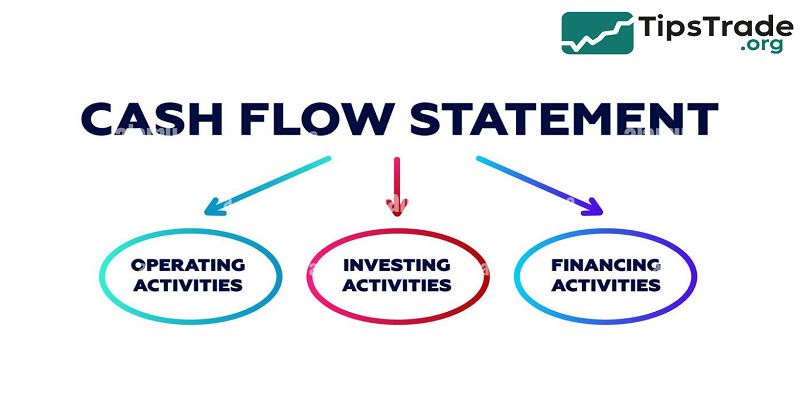Cash Flow Statement Analysis is a crucial process that helps assess a company’s financial health by examining the inflows and outflows of cash during a specific period. The analysis focuses on understanding the cash generated from operating, investing, and financing activities, which provides insights into the company’s liquidity, operational efficiency, and overall financial stability. Visit tipstrade.org and check out the article below for further information
What Is a Cash Flow Statement Analysis?

The cash flow statement is a financial report that shows how much cash a company generates, spends, invests, and returns to shareholders. While the income statement records revenue and expenses using accounting rules, cash flow focuses on real money movement.
This matters because companies do not pay employees, suppliers, or banks with accounting profits—they pay with cash.
A typical cash flow statement is divided into three sections:
- Operating activities (cash generated from core business operations)
- Investing activities (cash used for new assets, technology, or acquisitions)
- Financing activities (cash taken from or paid to lenders and shareholders)
Analysts use cash flow to answer questions like:
- Is the company’s profit real, or just accounting adjustments?
- Can it finance growth without issuing more debt?
- Does it generate enough cash to survive a downturn?
According to the Corporate Finance Institute (CFI), cash flow analysis often reveals business problems years before they appear in earnings reports.
In fact, many companies that collapsed—such as Enron and Carillion—reported strong earnings but weak operating cash flow.
Why Cash Flow Matters More Than Profit

Profit can be manipulated using accounting rules like depreciation estimates or revenue recognition timing. Cash cannot. Cash flow is considered one of the most reliable indicators of business strength.
A company can survive without profit temporarily—but it cannot survive without cash.
- Profit shows accounting performance
- Cash flow shows financial reality
Example:
- Company A reports a $10M profit, but customers have not paid yet → low cash flow
- Company B reports a $5M profit, but receives cash quickly and manages costs well → strong cash flow
Most investors prefer Company B because it has real liquidity.
McKinsey’s financial research shows that companies with strong and consistent operating cash flow outperform the S&P 500 over long periods. Warren Buffett has repeatedly stated that “earnings are an opinion, cash is a fact.”
Three Sections of the Cash Flow Statement

To understand a company’s cash health, investors examine each section, not just total cash flow.
Cash Flow from Operating Activities
This is the most important section for long-term investors. Operating cash flow shows how much cash the company generates from its primary business—selling products or services.
Operating cash flow starts with net income and adjusts for:
- Non-cash expenses (depreciation, amortization)
- Changes in inventory
- Changes in accounts payable and receivable
Why it matters:
- A company can fake profit—but not operating cash flow
- Growing CFO over multiple years shows strong demand and efficient operations
- Negative CFO may signal declining sales, poor cost control, or liquidity problems
Example:
- If a company reports $50M in profit, but accounts receivable rise dramatically, the business is not collecting cash. This is a red flag.
Investors should compare operating cash flow to net income:
- When operating cash flow is higher than net income → healthy
- When profit increases but operating cash flow falls → risk of manipulation or slowing sales
Cash Flow from Investing Activities
This section shows how the company invests cash into long-term assets:
- Factories, equipment, technology, patents
- Research & development
- Acquisitions or stakes in other firms
Because investments cost cash, this section is usually negative—and that’s not bad. In fact, negative investing cash flow often means the company is expanding.
Example:
- Amazon reported negative investing cash flow for many years as it built warehouses and AWS data centers.
- Investors who understood this became early winners.
Cash Flow from Financing Activities
Financing cash flow shows money flowing between the company, lenders, and shareholders:
- Issuing or repurchasing shares
- Raising or repaying loans
- Paying dividends
Positive CFF often means the company raised debt or equity. Negative CFF may mean it is paying down loans or rewarding shareholders.
Example:
- Startups often have positive financing cash flow because they need outside money to grow
- Mature companies like Apple often have negative financing cash flow because they buy back shares and pay dividends—a sign of financial strength
Investors should watch for:
- Excessive borrowing → risk during recessions
- Dilution from share issuance → reduces shareholder value
How Investors Read a Cash Flow Statement

Professional equity analysts follow a clear checklist when analyzing cash flow:
Check operating cash flow trend
- Is cash from operations positive and growing?
Compare OCF vs. net income
- Profit backed by cash = trustworthy numbers
Review capital expenditures
- Is the company investing for growth?
Evaluate financing
- Debt heavy or self-funded?
Calculate free cash flow (FCF)
- Cash left after investments = shareholder value
Even beginners can apply these five steps to spot strong companies.
Free Cash Flow (FCF): The Number Wall Street Cares About
Free cash flow is the cash left after the company pays for capital expenditures. It is one of the most important numbers in investing.
Formula:
FCF = Operating Cash Flow – Capital Expenditure
Why FCF matters:
- Growth companies need FCF to reinvest
- Mature companies use FCF to pay dividends and buy back shares
- High FCF means the business is self-sustaining, not dependent on loans
According to Morningstar, companies with strong and stable FCF outperform the market because they can:
- Expand without debt
- Survive recessions
- Return money to shareholders
Real Company Examples for Investors
Apple
Apple generates enormous operating cash flow because of global iPhone sales and subscription services. It uses this cash to:
- Buy back billions in shares
- Pay consistent dividends
- Acquire small tech companies
Apple’s high FCF is why it is one of the safest long-term investments.
Tesla
- Tesla had negative cash flow for many years while building factories and funding R&D.
- Analysts who understood this saw long-term potential instead of panic.
- Once Model 3 production scaled, Tesla moved into strong positive cash flow, proving that heavy investing can pay off.
Netflix
- Netflix often shows negative investing cash flow because it spends billions producing new content.
- Critics see this as a weakness, but strong subscriber growth eventually turns that spending into recurring revenue.
WeWork
- WeWork reported growing revenue but had deeply negative operating cash flow. It relied on debt and equity to survive.
- When capital dried up, the business collapsed. This is a powerful reminder: High revenue means nothing without real cash flow.
How to Detect Red Flags in Cash Flow Statements
Smart investors use cash flow analysis to avoid weak companies.
Common Warning Signs:
- Profit rises but operating cash flow falls
- Company borrows heavily to pay expenses
- Constant equity issuance (dilution)
- Large capital spending with no revenue growth
- Free cash flow consistently negative in a mature industry
Example:
A company reports $100M in net income but operating cash flow drops every year. This may mean:
- Customers are not paying
- Inventory is sitting in warehouses
- Accounting is aggressive
Investors should compare CFO, revenue, and debt over at least 3–5 years. One bad year is normal; a negative trend is not.
Cash Flow Ratios Every Investor Should Know

Cash Flow Margin
- Operating Cash Flow ÷ Net Sales
- Shows how efficiently revenue turns into cash. A rising margin is a good sign.
Cash Return on Assets (CROA)
- Operating Cash Flow ÷ Total Assets
- Shows how well management uses assets to generate cash.
Free Cash Flow Yield
- Free Cash Flow ÷ Market Cap
- Used to compare stocks. Higher yield = undervalued relative to cash.
Professional investors use these ratios to rank companies in the same industry.
Cash Flow Analysis vs. Income Statement
The income statement shows profit, but profit can be based on unpaid invoices or optimistic accounting.
Example:
- A company sells $50M of goods in December but collects cash next March.
- The income statement shows profit now.
- The cash flow statement shows reality later.
This is why investors read both—but trust cash more than earnings.
Two Companies with Very Different Cash Flow
| Company | Net Income | Operating Cash Flow | Risk Level |
| A | $50M | $5M | High risk – profit not collected |
| B | $30M | $42M | Strong – real cash and liquidity |
Even though Company A earns more money on paper, Company B is financially stronger.
How Cash Flow Predicts Stock Market Performance

Academic research shows a clear trend:
- Companies with strong free cash flow outperform over time
- Companies with weak or negative cash flow crash in recessions
When interest rates rise, debt becomes expensive. Companies with weak operating cash flow often collapse because they cannot refinance loans.
Investors who analyzed cash flow avoided many disasters, including:
- WeWork
- Bed Bath & Beyond
- Carvana (during the cash burn phase)
- Peloton
Conclusion
Cash Flow Statement Analysis ultimately empowers investors and management to make informed financial decisions by revealing the real cash position of a business beyond accounting profits. A thorough analysis indicates whether a company generates consistent positive cash flow, which is essential for sustaining operations and funding expansion. It also aids in identifying potential cash shortages early, enabling proactive measures to maintain financial health. Thus, mastering the cash flow statement analysis supports better risk management and long-term business success .

